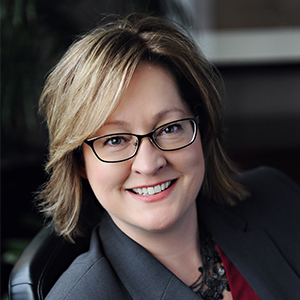PRACTICE PROFILE
| Print this Article |
Building Deep Client Relationships
Michele Clark of Acropolis Investment Management
By Kevin Adler

Michele Clark, CFP®, CRPC®, has worked for one of the largest retail investment companies in the nation, launched a solo Fee-Only RIA, and now is part of St. Louis-based Acropolis Investment Management, a Fee-Only firm with more than 40 staff members. Having seen many sides of the profession, Clark has landed in her sweet spot at Acropolis, where she’s a senior portfolio manager and able to focus her energies on helping clients plan comprehensively for their futures.
While working at a St. Louis branch of Schwab in 2003, Clark met one of the founders of Acropolis because the firm was designated by Schwab as one of the referrals when clients wanted discretionary management of their assets. She stayed in contact when she left Schwab in 2008 to raise her young children and earn certificates to start her solo RIA, which she launched in 2010. As she built her firm over the next few years, “Acropolis stayed in touch with me, referring clients to me who were a good fit for my firm,” she says. She soloed for nearly a decade before deciding to join Acropolis in 2019, which she calls “one of the best decisions I ever made.”
Growth Over 25 Years
Acropolis was founded in 1999 at a bank, but it split off in 2002 to become an independent Fee-Only RIA. Today, it employs 43 staff members to serve about 1,200 clients, and it manages more than $2.1 billion.
Clark manages about $80 million for 70 clients, and she says the service model is substantially different than her solo practice. Formerly, she primarily worked with clients on an hourly basis, and she developed and updated plans that clients implemented on their own. “They would come, and they would go away and might come back in a year or three years,” Clark says. “Many of them came over, and they love the extra service.”
Under Acropolis’s comprehensive planning, she’s with the clients through implementation and can look ahead at issues on their behalf. Sometimes, these matters go well beyond what might be thought of as financial planning. For example, she has three women clients whose husbands have dementia; for two of the women, it’s the first time they have become the point person for financial matters. “We have been spending a lot of time to find transportation for their husbands’ medical appointments, get them in contact with a geriatric care manager, find people to do their taxes if they have done them in the past,” she says. “We’ve researched in-home care versus assisted living versus nursing home options.”
Finding Value in ETFs
When it comes to managing clients’ money, Acropolis has come to rely on ETFs over the years. Clark says the firm believes ETFs are more versatile for professional money managers than mutual funds, which she feels are better for retail investors. She explains that most retail investors set their mutual funds up to reinvest dividends and capital gains by purchasing more of the fund’s holdings. Acropolis doesn’t do this, and whether it’s a mutual fund or an ETF, it can take those dividends and capital gains and deploy them in the smartest way, both in terms of investment goals and tax efficiency. “We let the cash build up and decide where the cash should go, which a retail investor might not have the time or expertise to do,” she says.
The firm uses multisector and value ETFs, as well as index ETFs, to build clients’ portfolios. Clark adds the firm still has mutual fund holdings in the fixed-income portion of allocations (though ETFs are the majority there as well), and it has some large-cap stocks for certain portfolios.
Each client’s portfolio is customized and built from core holdings monitored by the investment committee. “We do have models of how much goes into large-, mid-, and small-cap investments for portfolios of 5% stocks to 100%. We show it in pie charts,” she says. “But when it comes to implementing how to fill the pie chart, it is different for each client.”
Individual portfolios are built with taxes in mind, and it’s especially important for new clients, who often come with money in eight or 10 accounts, some of which are tax-deferred and some of which aren’t. “I’m very conscious of tax location and asset location strategies. I explain to clients in a get-acquainted meeting how much benefit they can get,” she says.
Whether it’s investments or researching geriatric care options, none of the services would be possible without dedicated team members who work together, Clark adds. The firm has an investment management committee, back-office experts for onboarding and account management, information technology (IT) experts, and more. “Twice a year, a local high school sends a group of students to shadow us. I introduce them to Matt, our IT person, and I tell them he’s why I came over to this firm,” she laughs.
Clark and the portfolio advisor who works with her to care for her clients set aside time twice each year to discuss how to modify workflows, identify clients’ needs, and improve overall service. “In January and then July/August, we have three weeks set aside without client meetings,” Clark says. “In January, we developed a giant list of to-dos for the new year to make sure the practice runs smoothly. In that pause, we really think about what we think clients need to know, what do we need to add to agendas or cut out that will not improve the service experience.”
Discussions in the July/August period focus on preparing for client tax return reviews and tweaking the template agenda for the fall tax planning meetings.
Throughout the year, Clark and the portfolio assistants who work with her are constantly on the lookout for ways to improve their efficiency and service. “I’m very much about workflows and checklists—I love The Checklist Manifesto by Atul Gawande,” she says.
Bringing Value to the Client Relationship
Typically, Clark meets with each client twice per year—and more often if they’re nearing retirement or facing other major changes in their lives. The spring meeting is for updating financial plans, reviewing investment portfolios, and deciding if new concerns have come up that need attention. Fall meetings include a discussion of tax changes that might affect clients, another investment portfolio review, and a look at whether the open items from the spring have been addressed. “The meetings keep the ball moving on the tasks they need to do,” Clark says.
For example, clients often drag their feet on wills and estate plans. “We’ll give them a referral to an estate attorney, but that’s often not enough,” she says. “The No. 1 way to move ahead is to get the client’s permission for the estate attorney to contact them.” Clark will send an introductory email to the attorney and copy the client, asking the attorney to contact the client to schedule their first meeting. When she meets with the client, she asks what date the meeting has been scheduled for and then asks again at the next meeting, if necessary.
One element of the meetings—in-person or on Zoom—that Clark enjoys and that is highly appreciated by clients is “live planning”—working through numerous scenarios in real time. She begins with a financial plan based on information she already has, but then Clark and her clients sift through new goals and alternative scenarios and see how the plan holds up.
“I’ve never been a believer that a client should just give me their information, and then I will give you a plan,” she says. “The idea is that we create a plan that you can stick with along the way.”
The sessions are collaborative. “It’s not me telling you that you need to do this so that you will be successful,” Clark says. “Instead, we have these variables we can adjust based on what’s more or less important to you. We get much stronger buy-in.”
She admits live planning can be stressful for the advisor because of the potential to get questions they can’t handle. Her advice: “Become well-versed in your planning software.”
Benefits of NAPFASince joining NAPFA in 2011, Michele Clark has been a regular attendee at NAPFA’s national conferences and a participant in the St. Louis study group meetings. “I love the study group,” she says. A typical study group meeting has a presenter or presenters covering a topic of general interest, followed by a Q&A. “One of the best ones was a number of years ago from a geriatric care management company and two other people in the industry,” she says. “I still refer clients to one of the presenters.” Clark derives similar value from attending NAPFA’s national conferences. “They have more advanced content than you can find at other conferences,” she says. “Whenever the agenda is ready, it’s almost like Christmas Day for me; there’s so much to pick from.” At the October 2023 NAPFA conference in Louisville, KY, for example, she says that a session about the rules for retired minimum distributions under the SECURE Act 2.0 was a highlight. She also praised Joe Messinger, CFP®, for his presentation on college planning and new Free Application for Federal Student Aid (FAFSA) rules. “It’s not just the presentation—the questions from the audience are excellent,” she says. “Sometimes I feel bad for the presenters if they didn’t understand that everyone in the room has passed the CFP® exam and that a basic presentation isn’t going to be enough.” On top of the sessions, Clark enjoys informal discussions with old friends and new colleagues. “These are people who understand your practice,” she says. “We share best practices. It opens your mind to new ideas or brings new solutions to ideas bouncing around in your head.” |
Acropolis Investment Management
Location: St. Louis
Website: acrinv.com
Year founded: 1999 (became independent, Fee-Only RIA in 2002)
Number of staff: 43
Number of clients: Approximately 1,200
Total assets under management: $2.1 billion
Typical clients and their needs: About two-thirds are 10 years or less from retirement or are in retirement. They need to know that their next egg will let them do the fun things they have been dreaming about and cover essential expenses in retirement.
Investment strategy and methods: For equities, mostly ETFs (multisector and value, as well as index ETFs) to provide diversification across large-, mid-, and small-cap U.S. stocks and across international developed and emerging markets. For fixed income, a mix of ETFs and mutual funds representing different market sectors and durations.
Favorite financial planning apps: Holistiplan, Advisor Engine CRM and its Meeting Monitor Report, and Social Security claiming strategy software.
Favorite financial planning websites: IRS, Kiplinger Tax Map State by State Guide to Taxes on Retirees Pension Rights Center, Kitces Premier Membership
Favorite nonfinancial planning websites: App to listen to books. Favorite recent book: Deep Work: Rules for Focused Success in a Distracted World by Cal Newton.
Advice to other advisors: “Create a curated list of people and resources so that when your client has a need, you can connect them to someone who can help. Not just CPAs and attorneys but also geriatric care managers, patient advocates, health insurance brokers, mortgage lenders, life, disability, and long-term care insurance agents, professional organizers, senior downsizing and life moving management companies, financial therapists, and even a travel agent. And more advice: Always be curious.”


